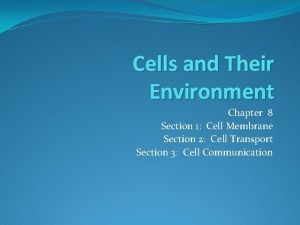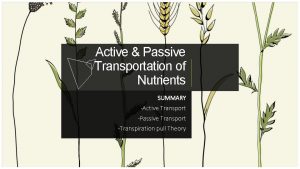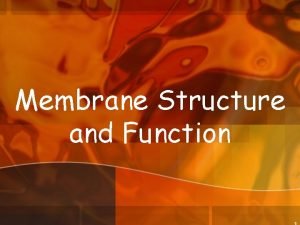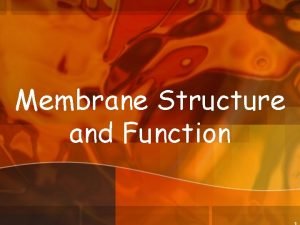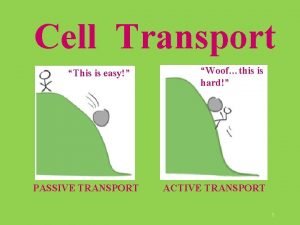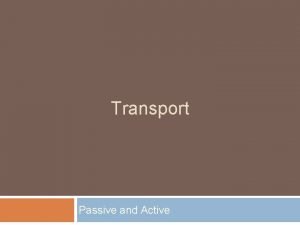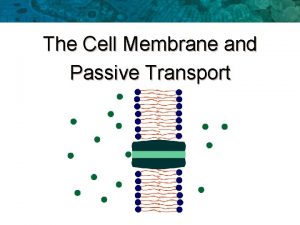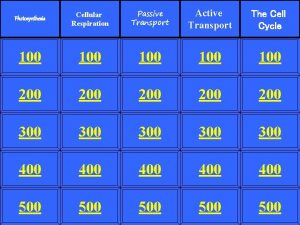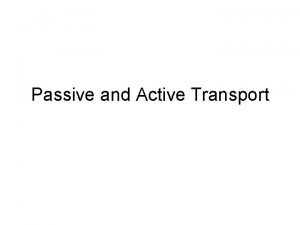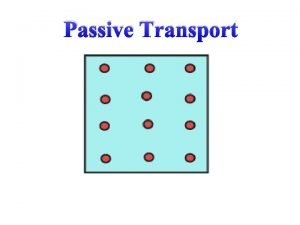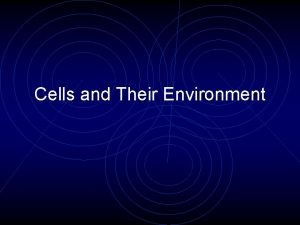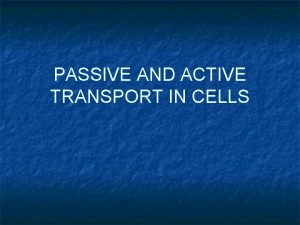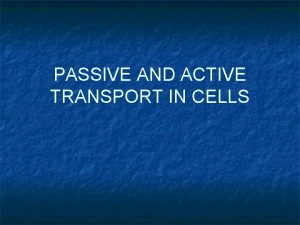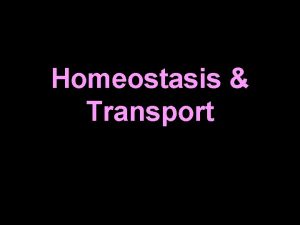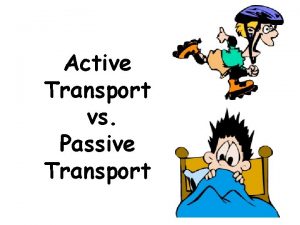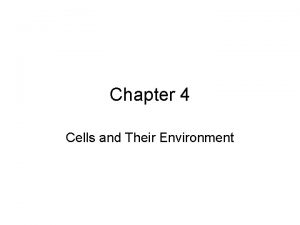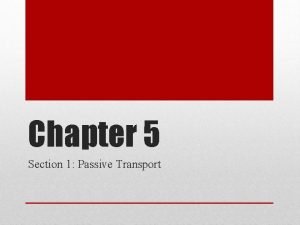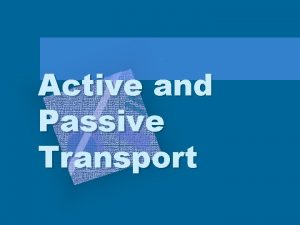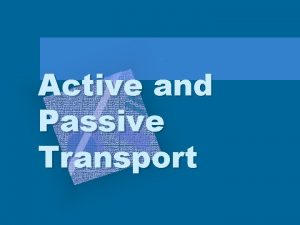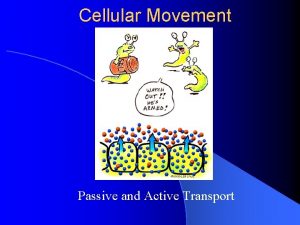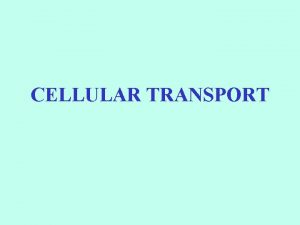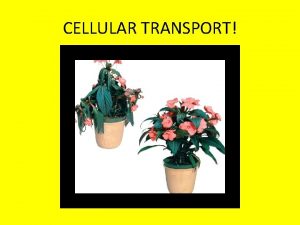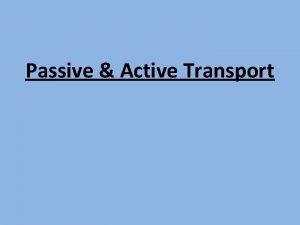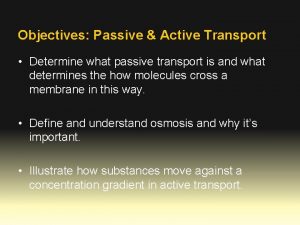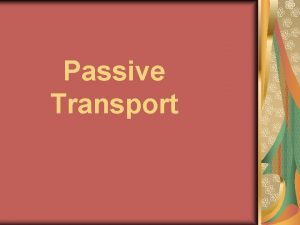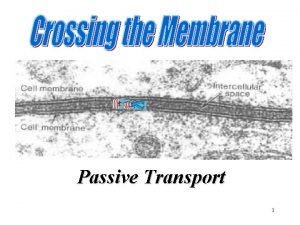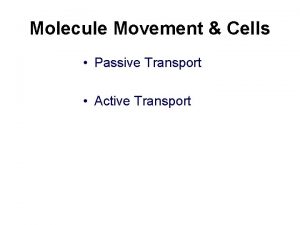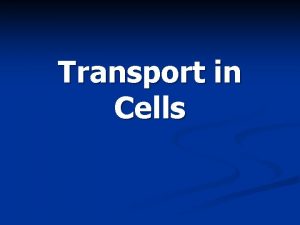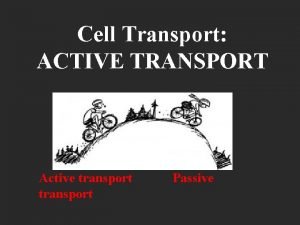Chapter 4 Cells and Their Environment Passive Transport




































- Slides: 36

Chapter 4 Cells and Their Environment

Passive Transport Ø What is Homeostasis? Ø Among all the forms of homeostasis one thing a cell will do is move molecules across the cell membrane. Ø Sometimes a cell will require energy to move molecules across the membrane and other times it does not. Ø The movement of a substance across a cell membrane without the use of energy is called passive transport. Ø Example: A crowded party.

Passive Transport cont. The difference in the amount of material between two areas is called a concentration gradient. Ø The difference in the concentration of a substance across a space. Ø

Movement of Substances Ø Ø Ø Moving from a room with a lot of people to a room with less people is an example of moving with the concentration gradient. What is an example of moving against the concentration gradient. When the amount of people is equal in the two rooms you have reached equilibrium this is when the concentration of a substance is equal throughout a space.

Osmosis and Diffusion – The movement of a substance from an area of high concentration to an area of lower concentration caused by random motion of particles. Ø Some particles move very easily across the membrane others need help. Ø Small particles can fit right between the phospholipids in a membrane, larger molecules like proteins need help in getting across. Ø Non-polar molecules move across the cell membrane much easier than polar. Why? Ø

Osmosis and Diffusion Cont. Ø Osmosis – The movement of water through the cell membrane. Ø If there is more water on the inside of a cell than on the outside the water will move out. Ø Being that only certain materials can move across the membrane it is said to be semipermeable.

Osmosis cont. Ø Sometimes the movement of water will be too great in one direction. Ø If there is too much of a substance, for instance sugar or salt, inside a cell which direction do you think water will move to stabilize the concentration? Ø Think about a water balloon. If you fill a balloon with water what happens to it? What happens when you squeeze the water out?

Moving Water Ø In which way will water move if there is less water outside of a cell than inside? Ø Hypertonic Solution – Water moves out of the cell. Cell shrinks. Ø Hypotonic Solution – Water moves into the cell. Cell swells. Ø If the amount of water is equal outside and inside the cell, the solution is isotonic. Ø Hypertonic means “Lots of stuff”


Hypertonic and Hypotonic Solutions

Hypertonic Solution Ø Red blood cells in a hypertonic solution Ø Plant cells in a hypertonic solution

Hypotonic Solution Ø Red blood cells in a hypotonic solution Ø Plant cells in a hypotonic solution

You tell me! Ø Red blood cell in a hypotonic solution. Ø Aren’t fish made of cells? Why don’t the cells of salt water fish shrivel up to nothing? What happens to humans in salt water? Why can’t a fresh water fish live in salt water?

Osmosis

The Cell Membrane Ø Larger molecules need a protein embedded in a cell membrane to move across.

Facilitated Diffusion Ø Facilitated Diffusion – is the use of a carrier protein to move molecules across a cell membrane. Ø Carrier Protein – is a transport protein that carries a specific substance across a cell membrane. Ø When a carrier protein is used to transport a specific substance, for instance, amino acids, proteins or sugars, the process is called facilitated diffusion.

Carrier Protein

Facilitated Diffusion cont. Ø The following are the steps of moving a substance across a cell membrane using facilitated diffusion: l Step 1: l Step 2: l Step 3: Molecule binds to a protein on one side of the cell membrane, causing the protein to change its shape. The change in shape sends the molecule across the phospholipid bilayer. The once open side of the protein, now closes, and the molecule is then released on the other side of the membrane.

Passive Transport in a nutshell. Protein

Movement of Substances Ø These channels allow for proteins, ions and other large molecules to cross. Na+, K+, Ca 2+ and ClØ These ions are very important for nerve impulses and muscle movement. Ø In order for these ions to work they need to be able to move in and out of the cell but they are too large to fit between the phospholipids and they can not move across the non-polar tails.

Movement of Ions Ø Ions have a charge, do you think that they can move across the non-polar part of the cell membrane? Ø The ions need the help of a protein called an ion channel to move across the cell membrane. Ø Ion Channel – protein with a polar pore through which ions pass.

Movement of Ions cont. Some ion channels are always open while others are gated. Ø The gated proteins can open with the stretching of a cell, change in electrical charge or by binding a specific molecule. Ø Ion channels do not require energy that means the movement of an ion is a form of passive transport. Ø The interior of a cell has a slight negative charge so would a negatively charged ion move in or out of a cell? What about a positively charged ion? Ø


Chapter 4. 2 Active Transport So far we have talked about movement of molecules in and out of a cell without the use of energy. What is this called? Ø Passive transport usually occurs when a molecule is moving from a high to low concentration or with the concentration gradient. Ø Active Transport – When a substance is transported from an area of low to high concentration or against the concentration gradient with the use of energy. Ø The energy that is used in active transport is supplied by. Ø

How Active Transport Works Ø Just like during facilitated diffusion sometimes active transport requires a protein to move a substance across the membrane. Ø Instead of being called a carrier protein these proteins are called “pumps” because they pump substances across the concentration gradient. Ø One example of this is the Sodium Potassium Pump.

Sodium Potassium Pump Ø The Sodium Potassium Pump is a type of carrier protein that transports 3 Na+ out of a cell and 2 K+ into the cell. Ø The Sodium Potassium Pump is a form of active transport so that means it requires Ø If Na+ is transported out of the cell using active transport where is the higher concentration? Ø What about in the case of K+?

Steps of the Sodium Potassium Pump Step 1: 3 Na+ ions inside the cell bind to the protein, along with a phosphate from ATP. Ø Step 2: The protein changes shape releasing the three Na+ ions to the outside of the cell. Ø Step 3: The pump is now exposed to two K+ ions outside of the cell. The two K+ ions bind to the protein causing it to change shape and lose the phosphate. Ø Step 4: The K+ ions are released into the cell and the protein is ready to bind to three Na+ ions again. Ø

Sodium-Potassium Pump

Passive and Active Transport

More Transport Ø Sometimes a cell needs to take in or release a lot of substances at one time. The cell uses a vesicle to do so. Ø Endocytosis – The movement of very large materials into a cell. Ø Exocytosis - The movement of very large materials out of a cell.

Endocytosis Ø Step 1 – A molecule from outside the cell meets the cell membrane and pushes the membrane in. Ø Step 2 – The membrane is forced to surround the molecule(s). Ø Step 3 – The membrane pinches off to form a vesicle.

Exocytosis Ø Step 1 – A vesicle is formed somewhere in the cell usually from the golgi or the ER. Ø Step 2 – The vesicle then moves to the inside of the cell membrane. Ø Step 3 – The membranes attach and open exposing the material inside the vesicle to the outside of the cell.

Endocytosis & Exocytosis

Receptor Proteins Ø Receptor protein – Protein that is able to bind to a signal, enabling a cell to respond. Ø The signal is usually a molecule like a hormone that triggers the response. Ø Example: How do all cells know how to grow at the same time. Ø Cell “A” gets the instructions from the brain to start growing. Cell “A” sends a hormone to Cell “B” and so on. Ø How do you think hormones get to the other cells?

Functions of Receptor proteins Ø Some receptor proteins can tell whether or not an ion channel should be working. Ø Some can activate a second messenger which acts as a signal inside the cell. Ø Some can activate an enzyme, triggering chemical reactions.

 Active transport and passive transport
Active transport and passive transport Cells and their environment worksheet answers
Cells and their environment worksheet answers Now answer the following questions
Now answer the following questions Passive transport vs active transport venn diagram
Passive transport vs active transport venn diagram Endocytosis vs exocytosis
Endocytosis vs exocytosis Nondisjunction in meiosis
Nondisjunction in meiosis Waters view
Waters view Chlorocruorin
Chlorocruorin Plant vs animal cells venn diagram
Plant vs animal cells venn diagram Masses of cells form and steal nutrients from healthy cells
Masses of cells form and steal nutrients from healthy cells Symport antiport uniport
Symport antiport uniport Membrane structures that function in active transport
Membrane structures that function in active transport Papillary duct of bellini
Papillary duct of bellini Thyroid parafollicular cells
Thyroid parafollicular cells How are somatic cells different from gametes
How are somatic cells different from gametes Why dna is more stable than rna
Why dna is more stable than rna Prokaryotic versus eukaryotic
Prokaryotic versus eukaryotic Prokaryotic cells vs eukaryotic cells venn diagram
Prokaryotic cells vs eukaryotic cells venn diagram The organelle trail
The organelle trail Pseudostratified vs simple columnar
Pseudostratified vs simple columnar Prokaryotic cells vs eukaryotic cells
Prokaryotic cells vs eukaryotic cells Is a staphylococcus cell prokaryotic or eukaryotic
Is a staphylococcus cell prokaryotic or eukaryotic Cells and life lesson 1 answer key
Cells and life lesson 1 answer key Primary active transport vs secondary active transport
Primary active transport vs secondary active transport Bioflix activity membrane transport active transport
Bioflix activity membrane transport active transport Isotonic in biology
Isotonic in biology Active and passive transport
Active and passive transport Difference of active and passive transport
Difference of active and passive transport Environment of business finance
Environment of business finance Active vs passive transport
Active vs passive transport Passive transport ex
Passive transport ex Cotransport
Cotransport 3 passive transport
3 passive transport Whats passive transport
Whats passive transport Passive transport
Passive transport Is photosynthesis active or passive transport
Is photosynthesis active or passive transport Types of active transport
Types of active transport

